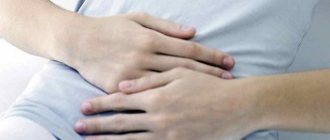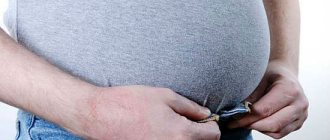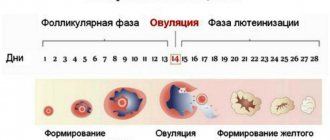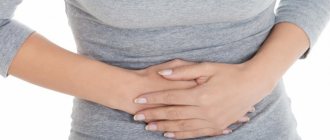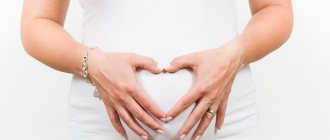Most of women's knowledge about how pregnancy begins ends at the stage of ovulation and fertilization. Actually, the success or failure of the planning cycle is attributed to the fateful “meeting” of male and female reproductive cells. However, in the development of new life in a woman’s body, there is another difficult and important point - embryo implantation. In order to increase the personal literacy of planning ladies, this issue should be given special attention.
Ovulation and timing of fertilization
OVULATION (from Latin ovum - egg) - the release of a mature egg capable of fertilization from the ovarian follicle into the abdominal cavity; stage of the menstrual cycle (ovarian cycle). Ovulation in women of childbearing age occurs periodically (every 21-35 days). The frequency of ovulation is regulated by neurohumoral mechanisms, mainly by gonadotropic hormones of the anterior pituitary gland and ovarian follicular hormone. Ovulation is promoted by the accumulation of follicular fluid and the thinning of the ovarian tissue located above the protruding pole of the follicle. of ovulation, which is constant for every woman, undergoes changes within 3 months after an abortion, within a year after childbirth, and also after 40 years, when the body prepares for the premenopausal period. Ovulation stops with the onset of pregnancy and after the cessation of menstrual function. Establishing the date of ovulation is important when choosing the most effective time for fertilization, artificial insemination and in vitro fertilization.
Signs of ovulation
Subjective signs of ovulation may include short-term pain in the lower abdomen. Objective signs of ovulation are an increase in mucous discharge from the vagina and a decrease in rectal (basal) temperature on the day of ovulation with an increase in it the next day, an increase in the content of progesterone in the blood plasma, etc. Ovulation are caused by dysfunction of the hypothalamic-pituitary-ovarian system and can be caused by inflammation genitalia, dysfunction of the adrenal cortex or thyroid gland, systemic diseases, tumors of the pituitary gland and hypothalamus, stressful situations. The absence of ovulation during childbearing age (anovulation) is manifested by a disturbance in the rhythm of menstruation such as oligomenorrhea (menstruation lasting 1-2 days), amenorrhea, and dysfunctional uterine bleeding. Lack of ovulation (anovulation) is always the cause of a woman’s infertility. Methods for restoring ovulation are determined by the cause that caused anovulation and require a visit to a gynecologist and special treatment.
A little theory
Introduction of fertilized egg into the uterus
called implantation. The embryonic villi penetrate the lining of the uterus, which may cause minor bleeding.
In order for implantation to be successful, several conditions must be met:
- lush three-layer endometrium with a high content of substances that nourish the embryo;
- high amount of progesterone in the body (so that the embryo can develop and menstruation does not begin);
- normal microflora in the body.
The process of fertilization and development of the fertilized egg is not a one-step process. And each stage is important for the onset of a normal pregnancy and the formation of a healthy fetus.
Ovulation and contraception
Some women experience peak sexual arousal around the days of ovulation . However, the use of a physiological method of contraception from pregnancy, based on sexual abstinence during ovulation , is especially difficult for young spouses, whose frequency of sexual intercourse reaches a fairly high level. In addition, with strong love excitement and nervous stress, additional ovulation can occur (especially with episodic, irregular intercourse) and then not one, but two eggs mature in one menstrual cycle. This should be kept in mind when choosing one or another method of contraception.
What to do to reduce bloating during ovulation
To reduce increased gas formation and abdominal discomfort, it is necessary to act in several directions at once:
- drink more clean drinking water;
- limit the intake of foods that cause fermentation;
- reduce the amount of salt in food;
- start taking magnesium (only with your doctor’s permission);
- exclude the intake of foreign estrogens (synthetic substances with estrogenic activity);
- help the liver cope with the load.
Next, about everything in order.
Replenishing the lack of clean water
Oddly enough, drinking plenty of fluids reduces swelling and helps remove excess fluid from the body, which, in turn, reduces the symptoms of flatulence.
This is interesting(!) According to information from The Institute of Medicine, the daily intake of fluid into the body (including water, drinks, juices in fruits and vegetables, soups, etc.) should be at least 2.8 liters - this is 9 230 ml glasses of any drink + liquid in food and products (nursing women need more - 13 glasses).
In the hot season, with intense physical activity, with eating disorders (vomiting, diarrhea), and high temperature, another 1.5-2.5 tbsp should be added to the usual diet. drinking.
Removing trigger foods
It is better to completely exclude from the daily menu those foods that make you bloated. During the ovulatory period, they can easily become a kind of “trigger lever” for the onset of bloating.
Most often, fermentation processes in the intestines are caused by:
- yeast bread;
- onion garlic;
- milk;
- legumes;
- cabbage;
- sweets;
- apples, grapes and others.
You may tolerate some of the listed products absolutely calmly, without discomfort or increased gas formation. Each organism is unique. It is very useful to keep your food diary and write down in it those foods that lead to unpleasant consequences. In the future, by avoiding them, bloating can be reduced or eliminated completely.
Starting a salt-free diet
Salt retains water. Too much salt in food means a lot of swelling and more bloating. A healthy woman only needs 1 teaspoon of salt per day .
So, if bloating begins, exclude salty, smoked, pickled foods, fast food, chips, crackers, etc. from your diet. They all contain a lot of salt and irritate the intestines, causing pain and discomfort.
Alcohol and sugary drinks also stimulate thirst and cause dehydration (and fluid retention) - be aware of this.
A handful of almonds – approximately 25 g. Contains 25% Daily Value of Magnesium
We saturate the body with magnesium
Magnesium helps remove excess water and thereby reduce bloating. Interestingly, this element also effectively helps fight PMS - improves mood and reduces water retention.
The daily intake of magnesium for women of reproductive age is 310-320 mg. You can choose foods rich in this microelement, or you can use magnesium preparations (indications and dosage must be prescribed by a doctor!).
According to research by American scientists, foods rich in magnesium:
- pumpkin seeds – 46% of the daily value of magnesium (DV) is contained in ¼ cup of seeds (16 grams);
- 70-85% dark chocolate – 33% DNM – per 100 g;
- almonds/cashews – 25% DNM – in ¼ cup of nuts (24-30 gr.).
Important(!) Magnesium preparations are prescribed with caution in combination with diuretics, heart medications or antibiotics, as they can provoke unpleasant consequences.
We reduce the intake of foreign estrogens
Many common substances and products we use every day contain chemical compounds that act like estrogen. They are called xenoestrogens or foreign estrogens.
Xenoestrogens are found in creams, color cosmetics, body and hair washes (parabens and phthalates), plastic containers and cleaning products.
During the preovulatory period, the level of your own estrogen is already high, and if you add external substances with estrogen activity, this leads to a manifold increase in bloating.
Parabens and phthalates have an estrogenic effect and increase flatulence during ovulation
in products are most often described as methyl, ethyl, butyl , propylparaben .
Phthalates are designated as diethyl phthalate DEP , di- n- butyl phthalate DnBP, di- isobutyl phthalate DiBP, phthalates.
Hence the following recommendation: to prevent the entry of foreign estrogens into the body, you must carefully choose cosmetics and care products, and also avoid storing food and drinking from plastic containers.
Helping the liver - detoxification
The liver is our natural filter. It takes and removes harmful substances, toxins, as well as excess hormones (including xenoestrogens) from the blood.
During ovulation, the load on the liver increases as it has to cope with a large amount of estrogen in the blood.
List of herbs that detoxify and reduce bloating:
- milk thistle;
- mint;
- dandelion;
- artichoke;
- parsley and others.
They can be consumed in the form of teas or tinctures.
You can help activate the liver with a very simple technique : you need to drink a glass of water with a slice of lemon in the morning on an empty stomach . In this way, the digestive system is “started” and the outflow of bile is stimulated, which, in turn, improves liver function and helps cope with flatulence.
Timing of ovulation
It should be noted that different women have a noticeable difference in the timing of ovulation . And even for the same woman, the exact timing of the onset varies from month to month. Some women have extremely irregular cycles. In other cases, cycles may be longer or shorter than the average of 14 days. In rare cases, it happens that in women with a very short cycle, ovulation occurs around the end of the menstrual bleeding period, but in most cases, ovulation occurs quite regularly.
If for one reason or another ovulation does not occur, the endometrial layer in the uterus is thrown out during menstruation. If the fusion of the egg and sperm has occurred, then the cytoplasm of the egg begins to vibrate very strongly, as if the egg is experiencing an orgasm. Sperm penetration is the final stages of egg maturation. All that remains of the sperm is its nucleus, where 23 chromosomes are tightly packed (half the set of a normal cell). The sperm nucleus now quickly approaches the egg nucleus, which also contains 23 chromosomes. The two nuclei slowly touch. Their shells dissolve and their fusion occurs, as a result of which they are divided into pairs and form 46 chromosomes. Of the 23 chromosomes of the sperm, 22 are completely similar to the chromosomes of the egg. They determine all physical characteristics of a person except gender. The remaining pair from the egg always contains an X chromosome, and from the sperm there may be an X or Y chromosome. Thus, if there are 2 XX chromosomes in this set, then a girl will be born, if XY, then a boy.
Can a gynecologist recognize the signs of ovulation in a woman?
Naturally! He can even see the symptoms visually. The cervical canal is filled with so-called cervical mucus - it protects the uterus from the penetration of harmful microorganisms, and sperm too. During ovulation, the mucus thins and becomes more fluid to allow sperm to reach the egg. A specialist is able to notice these signs during a gynecological examination.
There are also more modern methods for recognizing ovulation. Firstly, the main tool of gynecology and obstetrics is ultrasound. Secondly, the same luteinizing hormone test that you can do at home. Only in the clinic is blood taken for analysis, and laboratory equipment measures the level of the hormone in numbers and confirms ovulation with great accuracy.
Unfortunately, not all women have the opportunity to visit a specialist for several days in a row. But if you have it, this is, of course, an ideal option.
How to feel ovulation?
Some women claim that they experience special, unlike anything else sensations. And it immediately becomes clear to them: a wonderful time has come in which they can give birth to a new life. Medicine treats pregnancy planning based on one’s own feelings with caution and believes that the moment of ovulation itself is impossible to feel - the body does not send any strong signals (pain, spasm, sudden release of hormones).
Often during the period of ovulation, plus or minus a few days, a woman experiences increased sexual desire. Research confirms that such a connection does exist, for example, it is during this period that women tend to choose the most revealing outfits from their wardrobe. Of course, your feelings will not tell you the exact day - only an approximate period. And in general, who knows why today you want love and mini? Maybe these are signs of ovulation, or maybe it’s just spring
Ovulation, conception and gender of the child
Research conducted at the National Institute of Environmental Health Sciences (North Carolina) has shown that not only the actual conception of a child, but also its gender depends on the time of conception in relation to the time of ovulation .
The chance of conception is highest on the day of ovulation and is estimated at approximately 33%. A high probability is also noted on the day before ovulation - 31%, two days before it - 27%. Five days before ovulation the chance of conception is estimated to be 10%, four days before ovulation is 14% and three days before ovulation is 16%. Six days before ovulation and the day after ovulation, the likelihood of conception during sexual intercourse is very low.
If we consider that the average “life expectancy” of sperm is 2-3 days (in rare cases it reaches 5-7 days), and the female egg remains viable for about 12-24 hours, then the maximum duration of the “dangerous” period is 6- 9 days and the “dangerous” period correspond to the phase of slow increase (6-7 days) and rapid decline (1-2 days) before and after the day of ovulation , respectively. Ovulation , as noted above, divides the menstrual cycle into two phases: the follicle maturation phase, which with an average cycle duration is 10-16 days and the luteal phase (corpus luteum phase), which is stable, independent of the duration of the menstrual cycle and is 12- 16 days. The corpus luteum phase refers to the period of absolute infertility; it begins 1-2 days after ovulation and ends with the onset of a new menstruation.
Bloating after ovulation as an early sign of pregnancy
This feeling is often considered one of the first signs of pregnancy. The reason for such sensations is a change in the endometrium, which is accompanied by damage to tissues and blood vessels. In this case, the fertilized cell attaches to the walls of the uterus, which causes pulling sensations in the lower abdomen.
The pain is sometimes accompanied by light bloody implantation discharge, nausea, and swelling of the mammary glands. Taken together, these signs indicate that conception has occurred. You can do a test to check whether conception has occurred one and a half to two weeks after the appearance of bloating and other symptoms.
But it must be borne in mind that in the case of pregnancy, bloating can also signal that the fertilized egg has attached in the wrong place and an ectopic pregnancy has occurred. An ultrasound examination performed as soon as possible will help eliminate this possibility.
Physiological reasons
Perhaps the cause of pain is physiological factors. The closer the period of ovulation, the more a special hormone – progesterone – is produced in a woman’s body. It is necessary so that the fertilized egg can be firmly fixed in the uterus by relaxing the muscles of the organ. In the human body, control is controlled by the autonomic system; as a result, relaxation is recorded in all organs in the middle of the cycle. The intestinal tract inevitably succumbs to the influence of progesterone, which contributes to an increase in the amount of gases in the organ, hence the absence of bowel movements for a long time, bloating and impaired intestinal motility.
Along with bloating, nausea and vomiting appear. Symptoms of body poisoning with toxins may appear as a result of the accumulation of gases. This occurs due to partial absorption of carbon dioxide into the bloodstream and distribution to other internal organs. There are complaints of headache, general malaise, and a feeling of weakness. A woman notices a sleep disorder.
Why doesn't ovulation occur?
- To begin with, it should be clarified that it does not occur in every cycle, which means that conception may not occur in any month.
- Under the influence of external factors (stress, medication), the cycle changes duration, that is, the time of ovulation shifts.
- The cause of the failure may be a disease of the reproductive system - for example, polycystic ovary syndrome. In this case, ovulation either occurs irregularly or is completely absent.
- Hormonal disruptions also lead to disturbances: for example, due to stress, the level of the hormone prolactin increases, which suppresses the synthesis of hormones necessary for the release of the egg from the follicles.
If tests show irregular ovulation or a cycle without ovulation, and you are planning a pregnancy, you should consult a doctor who will determine the cause of the problem and prescribe treatment. Thus, for polycystic ovary syndrome, preparations containing inositol, alpha-lipoic acid and vitamin D3 are recommended - for example, the Diferton complex (more information about the product can be found here). All these components contribute to the maturation of eggs, that is, they normalize the functions of the ovaries and the ovulation process.
Vitamin and mineral complexes, which include vitex extract, help restore the cycle in case of hormonal imbalances. Thus, the drug Pregnoton received good reviews (more information is presented here). Having a gentle effect on the body, vitex extract reduces prolactin levels, and iodine normalizes hormonal levels. L-arginine improves blood flow in the pelvic organs.
In addition, a lot depends on the woman herself. To normalize ovulation, you need not only to take medications prescribed by your doctor, but also to give up alcohol and smoking, balance your diet, lead an active lifestyle, and try to avoid stress.
THIS IS NOT AN ADVERTISING. THE MATERIAL WAS PREPARED WITH THE PARTICIPATION OF EXPERTS.
Treatment of diseases accompanied by bleeding
You should not self-medicate; you should go to a clinic for medical help. Only a doctor will be able to study the symptoms in detail and determine the cause of the discharge.
Brown discharge, which is accompanied by a delay in menstruation or natural aging of uterine tissue, requires correction in diet and abandonment of bad habits.
It can be recommended to drink more water, since the problem may arise due to a decrease in water balance in a woman’s body.
If dark discharge appears as a result of diseases (cancer, erosion, infection), hormonal medications, antibiotics, chemotherapy, and dietary supplements are prescribed.
Surgery is possible in severe cases.
For additional treatment, you can douche with soda or chamomile, which will help relieve inflammation and speed up the healing process of the vaginal mucosa.
The entire course of therapy is carried out under the supervision of the attending physician.
After antibiotic therapy, measures are taken to restore the natural microflora of the vagina - lactobacilli and physiotherapy are prescribed.
The doctor must order follow-up tests at the end of the course of treatment to check how effective the treatment was.
If necessary, re-treatment is carried out.
Important! Self-treatment can lead to complications.
When to see a doctor?
In fact, the line between just pain during ovulation and pain that is a good reason to see a doctor is very, very blurry. If only because, as has been said more than once, everything is very individual for everyone, which is why each case requires separate consideration. However, there are a couple of symptoms that should alert a girl.
Firstly, these pains are regular. They always occur at the same time and last quite a long time. Secondly, they are so strong that they interfere with your daily activities. Thirdly, in addition to pain, you experience weakness during ovulation, dizziness, nausea, and these symptoms do not go away for more than a day. That's when you need to make an appointment with a doctor.
To avoid worries, remember two simple rules. First, listen to yourself, observe and try to record the norm in order to distinguish it from disturbing symptoms. Secondly, you need to visit a gynecologist with subsequent smear tests and ultrasound of the genitals and abdominal cavity at least once a year. Then you will know exactly what your personal signs of ovulation are and when to expect it.

